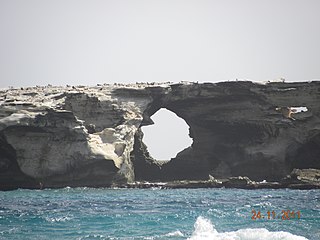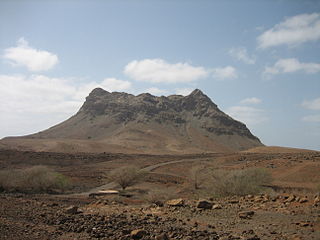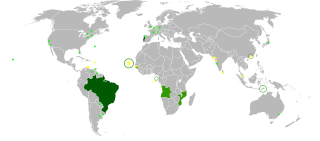
Santiago is the largest island of Cape Verde, its most important agricultural centre and home to half the nation’s population. Part of the Sotavento Islands, it lies between the islands of Maio and Fogo. It was the first of the islands to be settled: the town of Ribeira Grande was founded in 1462. Santiago is home to the nation's capital city of Praia.

Sal Rei is a city on the northwestern coast of the island of Boa Vista in eastern Cape Verde. Sal Rei is the island's main urban settlement, and the seat of the Boa Vista Municipality. In 2010 its population was 5,778. The name of the settlement means "Salt King" in Portuguese. This name stems from when the island's main industry was salt production.

Praia de Chaves is a beach in the western part of the island of Boa Vista in Cape Verde, close to the town Rabil. It is about 5 km long.

Praia das Gatas is a sandy beach in the northeastern part of the island of Boa Vista in Cape Verde. The nearest village is Fundo das Figueiras, 5 km to the southwest. It forms a part of Northern Nature Park. The small island Ilhéu dos Pássaros lies off the coast at the Praia das Gatas.

Praia de Atalanta is a beach on the north coast of the island of Boa Vista in Cape Verde. It is approximately 6 km northeast of the island capital of Sal Rei and 3 km west of Vigía. The wreck of the Spanish cargo ship Cabo Santa Maria, which ran aground on September 1, 1968, is located here.

The Deserto de Viana is a sand desert in the northwestern part of the island of Boa Vista, Cape Verde. It is situated east of the towns Rabil and Sal Rei, and west of Bofarreira. The desert itself is not a protected area, but it is adjacent to the nature reserve Boa Esperança, which includes the Lagoa do Rabil and the Praia de Atalanta.

Morro Negro is a hill located near the east coast of the island of Boa Vista, Cape Verde. Its elevation is 156 m. The nearest village is Cabeça dos Tarrafes, 5.5 km to the northwest.

Povoação Velha is a village in the southwestern part of the island of Boa Vista, Cape Verde. The village is around 16 km south of the island capital Sal Rei.

The Ilhéu de Curral Velho and adjacent coast Important Bird Area lies in the southeastern part of the island of Boa Vista in the Cape Verde archipelago off the coast of north-west Africa in the Atlantic Ocean. It is a 986 ha site consisting of the Ilhéu de Curral Velho, as well as the area opposite it on Boa Vista centred on the deserted village of Curral Velho. It was designated as a Ramsar wetland of international importance on July 18, 2005.

Rocha Estância is a mountain in the southwestern part of the island Boa Vista in Cape Verde, east of the village of Povoação Velha. Its elevation is 357 meters. It is part of a protected area covering 253 ha. The Our Lady of Conception church is located at the western foot of the mountain.

Praia de Cabral is a beach on the northwest coast of the island of Boa Vista in Cape Verde in the immediate area of the town of Sal Rei. Nearby in Praia de Fátima is an abandoned chapel of Our Lady of Fatima.

Monte Santo António is a mountain in the southwestern part of the island Boa Vista in Cape Verde. At 379 m (1,243 ft) elevation, it is the island's second highest point. Like Rocha Estância and Monte Estância, it rises steeply from the surrounding plains. It is part of a protected natural area under the statute of natural monument, covering 459 hectares.

Ervatão or Porto de Ervatão is a beach on the southeast coast of the island of Boa Vista in Cape Verde. At its eastern end is the headland Ponta de Ervatão. Ervatão is part of the Turtle Nature Reserve. The area of Ervatão receives 70% of all turtles nesting on Boa Vista. In July 2009, 8,000 turtle nests were counted.

Praia da Varandinha is a beach on the southwest coast of the island of Boa Vista in Cape Verde. It lies north of the headland Ponta Varandinha. The beach forms part of the protected area Morro de Areia Nature Reserve.

Monte Caçador and Pico Forcado Protected Countryside is a protected area covering 3,357 hectares (12.96 sq mi) of land in the eastern part of the island of Boa Vista in Cape Verde. It is the most important mountain formation on the island, but not the highest.

Morro de Areia Nature Reserve is a nature reserve covering the southwestern coast of the island of Boa Vista in Cape Verde. It takes its name from the hill Morro de Areia, 167 m (548 ft) elevation. The natural reserve covers 21.31 km2 of land area, and stretches along the coast from the Praia de Chaves in the north to the Praia de Santa Monica in the south. The reserve includes a 300 m wide marine protection zone, an additional 4.36 km2.

Ilhéu dos Pásaros is a small uninhabited islet in the Cape Verde archipelago. It lies about 700 meters off the northeastern coast of the island of Boa Vista, near the beach Praia das Gatas. The area of the islet is 0.82 hectares (0.0032 sq mi)); with 38 ha of surrounding marine area it forms a protected area. It is a low, flat islet, covered with sedimentary material and sand. It is connected with the main island by a chain of reefs and volcanic rocks. It is an important nesting site for white-faced storm petrel and band-rumped storm petrel.

Praia de Carquejinha is a beach on the south coast of the island of Boa Vista in Cape Verde Neighboring beaches are Praia de Santa Mónica to the west and Praia de Curral Velho to the east. The beach is about 8 km long.





















